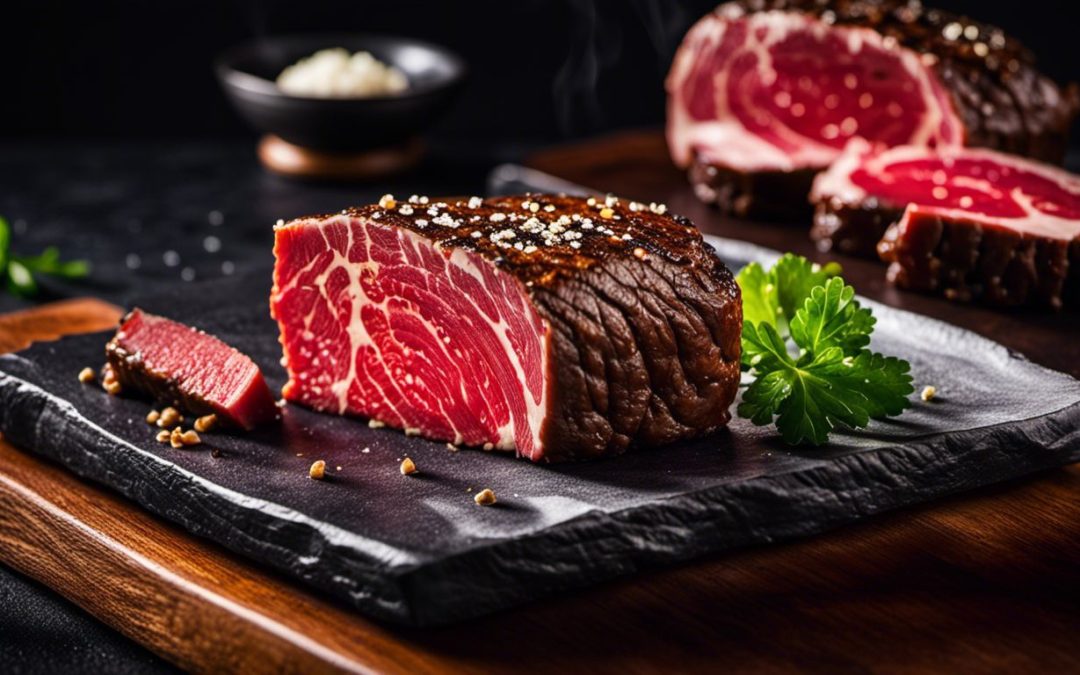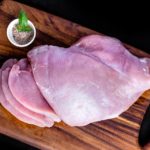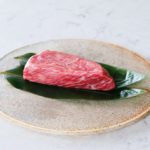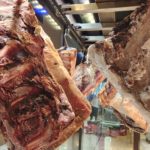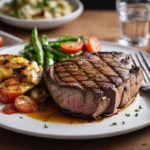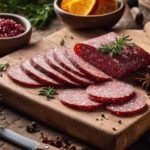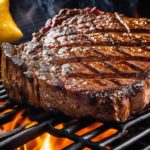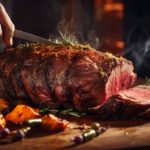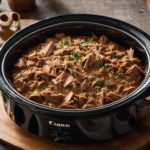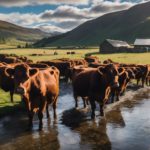Ever wonder what sets Kobe beef apart from the renowned Wagyu? It’s a mystery we’ve pondered too, considering that both are praised as the pinnacle of fine dining. Through our in-depth exploration, we discovered that while all Kobe is Wagyu, not all Wagyu is Kobe.
Our blog will help unravel these intricate distinctions between these two luxurious forms of beef – their origin, raising methods, taste profile and much more. Let’s get moo-ving!
Key Takeaways
- Kobe beef is a type of Wagyu beef that comes from the Tajima strain of Japanese Black cattle raised in the Hyogo prefecture of Japan.
- The price of Kobe beef is higher because it requires a specialized process and adherence to strict regulations set by the Japanese government.
- Authentic Kobe beef can only be found in Japan, specifically in the Hyogo prefecture, due to its geographical distinction.
Understanding Kobe Beef

Kobe Beef is a highly sought-after type of beef that comes from a specific breed of cattle called Japanese Black, which is raised in the Hyogo Prefecture of Japan.
What is Kobe Beef?
Kobe beef is a decadently delicious kind of Wagyu beef that hails from the Tajima strain of Japanese Black cattle. The journey to become Kobe beef starts and ends in Hyogo prefecture, Japan, where these cows are born, nurtured and processed.
Distinct geographical influence sets it apart from other types of Wagyu. Renowned for its tenderness, unique flavor and high-quality marbling, Kobe beef maintains absolute supremacy in the world of prime meats.
Strict regulations govern its production ensuring only the finest cuts earn this prestigious title. As a result of such rarity coupled with unmatched quality, it commands a higher price than regular meats across international markets.
This succulent delight can be savoured at select restaurants or specialty butcher shops on a global scale.
Why are Kobe beef prices so high?
Raising Kobe beef requires a highly specialized process that contributes to its high cost. Each Kobe cow, which comes from the Tajima strain of Japanese Black breed, must be born and processed in Japan’s Hyogo prefecture.
We ensure their diet consists of quality grains for about 600 days – substantially longer than regular cattle feeding time. This process results in the splendid marbling for which Kobe is famed.
Not just that, but adhering to stringent regulations set by the Japanese government maintains Kobe’s elite status and unparalleled quality; hence every piece of meat is authenticated with a unique 10-digit number traceable back to an individual cow! This labor-intensive cultivation limits production as well as increasing demand globally, resulting in elevated prices of authentic Kobe beef.
Is True Kobe Beef Only Found in Japan?
Yes, authentic Kobe beef can only be found in Japan. This exquisite meat comes from the Tajima strain of Japanese Black breed cattle exclusively raised in Hyogo prefecture. Only there, they’re pampered with a special diet and monitored closely to meet stringent guidelines for quality and marbling, leading to the tender, flavor-rich taste that sets it apart.
The geographic distinction is vital – even if similar techniques are used elsewhere in the world on Japanese Black cattle descended from original Wagyu bloodlines, unless they’re born and raised within Hyogo’s borders under official supervision, it doesn’t qualify as true Kobe beef.
In essence, genuine Kobe beef is not just about the breed but also where and how these animals are reared.
How do farmers raise genuine Kobe beef cattle?
Farmers raise genuine Kobe beef cattle by adhering to strict protocols and providing them with the utmost care:
- Farmers ensure that Kobe beef cattle are born and raised exclusively in the Hyogo prefecture of Japan.
- They carefully select and breed only the Tajima strain of the Japanese Black breed, known for its superior meat quality.
- The cattle are given a specialized diet consisting mainly of high – quality grains, which contributes to their unique flavor and marbling.
- Farmers focus on creating a stress – free environment for the cattle, as this helps maintain their tender and succulent meat.
- Regular health checks and veterinary care are provided to ensure the well – being of the animals.
- Cattle are often massaged to improve blood circulation and enhance marbling development.
- The farmers monitor every aspect of their growth, paying attention to factors like exercise, temperature control, and overall living conditions.
Understanding Wagyu Beef

Wagyu beef is known for its incredible marbling, resulting in a tender and flavorful steak. Learn more about the requirements for Japanese beef to be considered Wagyu or Kobe and how it compares to USDA Prime beef.
Read on to discover why Wagyu beef is truly one-of-a-kind!
What is Wagyu Beef?
Wagyu beef is a type of meat that comes from special breeds of Japanese cattle. The word “Wagyu” actually means “Japanese cow.” What makes Wagyu beef so unique is the high level of marbling, which refers to the fine lines of fat that are evenly distributed throughout the meat.
This marbling gives the beef its rich flavor and melt-in-your-mouth texture. Wagyu beef is highly regarded for its tenderness, juiciness, and exceptional taste. It’s no wonder that it’s considered one of the finest types of beef in the world!
Marbling: The Wagyu Difference
Kobe beef and Wagyu beef have a distinct difference when it comes to marbling. Marbling refers to the white specks of fat that are interspersed throughout the meat. In the case of Wagyu beef, especially Kobe beef, the marbling is incredibly intricate and abundant.
This high level of marbling gives the meat its famous melt-in-your-mouth texture and contributes to its intense flavor. It’s this exceptional marbling that sets Kobe beef apart from other types of beef and makes it so highly sought after by meat lovers around the world.
What are the requirements for Japanese beef to be Wagyu or Kobe?
Japanese beef must meet specific requirements to be classified as either Wagyu or Kobe:
- Origin: Japanese beef must come from cattle raised in Japan.
- Breed: Wagyu beef can come from four specific breeds of cattle, including Japanese Black, Japanese Brown, Japanese Polled, and Japanese Shorthorn. Kobe beef specifically comes from the Tajima strain of the Japanese Black breed.
- Feeding: Cattle that produce Wagyu or Kobe beef are fed a special diet that includes high-quality grains and grasses to enhance marbling.
- Processing: To be considered authentic Wagyu or Kobe beef, the cattle must be born, raised, and processed in Japan.
- Quality standards: Both Wagyu and Kobe beef adhere to strict quality specifications, ensuring a certain level of tenderness, flavor, and marbling.
How does Japanese beef compare with USDA Prime beef?
Japanese beef, including both Kobe and Wagyu, is known for its superior taste, marbling and texture, making it highly sought after by meat lovers globally. Let’s compare it with USDA Prime beef, the highest grade of beef in the United States.
| Characteristic | Japanese Beef (Wagyu/Kobe) | USDA Prime Beef |
|---|---|---|
| Origin | Wagyu cattle are native to Japan. Kobe beef specifically comes from the Tajima strain of the Japanese Black breed of cattle, raised and processed in the Hyogo prefecture of Japan. | USDA Prime beef comes from various breeds of cattle raised in the United States. |
| Marbling | Japanese beef is known for its intense marbling, which contributes to its superior taste and texture. | USDA Prime beef has high degree of marbling, considered to be the top 2-3% of all meat available in the U.S. However, it may not be as marbled as Japanese beef. |
| Flavor and Texture | Kobe and Wagyu beef are known for their tenderness, juicy flavor, and high-quality marbling, which make them melt in your mouth. | While USDA Prime beef is also known for its flavor and tenderness, it may not be as tender or flavorful as Japanese beef due to less marbling. |
| Price | Japanese beef is considered a luxury item and is often more expensive than other types of beef due to its quality and rarity. | USDA Prime beef is expensive, but typically less pricey than Japanese beef. It’s considered the highest quality beef available in the U.S. market. |
| Availability | Kobe beef and Wagyu beef are available in high-end restaurants and specialty butcher shops around the world, but they may not be as widely available as USDA Prime beef. | USDA Prime beef is widely available across the U.S. It can be found at butcher shops, supermarkets, and served at high-end restaurants. |
Although both are exceptional choices for beef lovers, the choice between Japanese beef, including Kobe and Wagyu, and USDA Prime beef really comes down to personal preference, budget, and availability.
Differences Between Kobe Beef and Wagyu Beef
Kobe beef and Wagyu beef have several differences that distinguish them from each other, including cattle breeds, diet, marbling, flavor, price, and availability outside of Japan.
Cattle Breeds
Kobe beef and Wagyu beef come from different cattle breeds. Kobe beef comes specifically from the Tajima strain of the Japanese Black breed of cattle. These cattle are raised, born, and processed in the Hyogo prefecture of Japan.
They are known for their superior genetics and ability to produce high-quality marbling. On the other hand, Wagyu refers to all Japanese beef and includes various breeds such as Japanese Black, Japanese Brown, and Japanese Shorthorn.
While Kobe beef is a type of Wagyu beef, it is considered the best due to its strict specifications and geographical distinction.
Diet
Kobe beef and Wagyu beef have a special diet that contributes to their unique flavor and marbling. The cattle are fed with a precise and carefully regulated diet to ensure the highest quality meat.
Their feed consists of high-quality grains, such as rice straw, corn, and wheat bran, which helps to develop the rich marbling that is characteristic of these types of beef. Additionally, they may be given beer or sake during their feeding period to stimulate appetite and increase fat distribution throughout the meat.
This specialized diet plays a crucial role in producing the tender texture and intense flavor that meat lovers crave when enjoying Kobe or Wagyu beef.
Marbling
Kobe beef and Wagyu beef are both known for their intricate marbling. Marbling refers to the white streaks of fat that run through the meat, giving it a juicy and flavorful taste. The marbling in Kobe beef is particularly exceptional, making it incredibly tender and rich in flavor.
This marbling is achieved through careful breeding, feeding, and raising of the cattle. The high level of marbling in Kobe beef adds an extra layer of deliciousness to every bite, making it a true delicacy for meat lovers.
Flavor
Kobe beef and Wagyu beef are known for their remarkable flavor. The marbled fat that runs through these cuts of meat gives them a rich and luxurious taste unlike any other. When you take a bite of Kobe or Wagyu beef, you can expect a melt-in-your-mouth tenderness that is incredibly satisfying.
The intense marbling not only adds to the juiciness of the meat but also imparts a unique buttery flavor that truly sets it apart from regular beef. Whether you’re enjoying a perfectly seared steak or indulging in some deliciously marbled burgers, the exceptional flavor of Kobe and Wagyu beef is sure to leave your taste buds craving more.
Price
Kobe beef and Wagyu beef are known for their exceptional quality, and this is reflected in their price. Both types of beef are more expensive compared to regular beef because they offer a one-of-a-kind dining experience.
The intricately marbled meat of Kobe and Wagyu cattle is highly sought after by meat lovers around the world. The rarity and superior taste of these premium beef varieties contribute to their higher cost.
Whether enjoyed at high-end restaurants or purchased from specialty butcher shops, Kobe and Wagyu beef are worth the investment for those who appreciate the finest flavors in their steak.
Availability Outside Japan
Kobe beef and Wagyu beef, including Kobe beef, can be found in high-end restaurants and specialty butcher shops around the world. Despite its rare and premium status, Kobe beef is available outside of Japan due to global demand for this exceptional meat.
Meat lovers can indulge in the tenderness, intense flavor, and high-quality marbling of Kobe and Wagyu beef by seeking out reputable establishments that offer these prized cuts. So whether you’re in New York City or Paris, there’s a chance you can savor the exquisite taste of Kobe or Wagyu beef without having to travel all the way to Japan.
Buying Authentic Japanese Beef and American Wagyu
Learn how to identify authentic Japanese beef and discover the differences between American Wagyu and Japanese Wagyu/Japanese Kobe Beef. Don’t miss out on enjoying the best beef experience!
Domestic Wagyu and Kobe-Style Beef
Domestic Wagyu and Kobe-Style Beef are alternatives for those who want to experience the unique qualities of Japanese beef without splurging on authentic Kobe beef. While they may not have the same geographical distinction as Kobe beef, domestic Wagyu and Kobe-style beef still offer exquisite flavor and marbling.
Domestic Wagyu is produced in the United States using crossbred Wagyu cattle that have been raised in a similar manner to their Japanese counterparts. On the other hand, Kobe-style beef refers to American-raised cattle that have been bred with Japanese breeds such as Angus or Holstein to replicate some of the characteristics of true Kobe beef.
These alternatives can be found in select restaurants and butcher shops around the world, providing meat lovers with an opportunity to savor the succulence and tenderness that make Japanese beef so highly regarded.
How to identify authentic Japanese beef
When looking to identify authentic Japanese beef, there are a few key factors to consider. Here are some tips to help you ensure that you are getting the real deal:
- Look for the label: Authentic Japanese beef, including Kobe and Wagyu, will often have a label or certification that indicates its origin. Look for labels that specifically mention Japan or the specific region where it was produced.
- Check the marbling: One of the distinguishing features of Japanese beef is its high level of marbling. The meat should have visible streaks of fat running through it, giving it a melt-in-your-mouth texture and rich flavor.
- Consider the price: Authentic Japanese beef is known for being quite expensive due to its rarity and quality. If you come across a deal that seems too good to be true, it’s likely not authentic.
- Know your source: To ensure authenticity, buy from reputable sources like specialty butcher shops or trusted online retailers that specialize in Japanese beef products.
- Read reviews or seek recommendations: If you’re unsure about a particular brand or restaurant offering Japanese beef, take the time to read reviews or seek recommendations from trusted sources who have tried it before.
Differences between American Wagyu/American Kobe and Japanese Wagyu/Japanese Kobe Beef
There are distinct differences between American Wagyu/American Kobe and Japanese Wagyu/Japanese Kobe Beef. Let’s break it down through a comparison table.
| Characteristic | American Wagyu/American Kobe | Japanese Wagyu/Japanese Kobe |
|---|---|---|
| Cattle Breed | American Wagyu are often crossbred with Angus cattle. | Japanese Wagyu like Kobe beef comes from the Tajima strain of the Japanese Black breed of cattle. |
| Diet | The diet may include grains, grasses, and may not be as strictly controlled as in Japan. | Japanese Wagyu cattle, especially those raised for Kobe beef, follow a very specific and controlled diet. |
| Marbling | American Wagyu beef has a high degree of marbling, but not typically as much as its Japanese counterpart. | Japanese Wagyu, including Kobe beef, is known for its intricate, high-quality marbling. |
| Flavor | While delicious, the flavor of American Wagyu is often not as intense as that of Japanese Wagyu. | Japanese Wagyu, and particularly Kobe beef, is renowned for its intense flavor. |
| Price | American Wagyu is costly, but generally more affordable than Japanese Wagyu. | Japanese Wagyu and Kobe beef are known to be more expensive due to their quality, rarity, and strict raising practices. |
| Availability | American Wagyu is more readily available in the US due to local production. | Authentic Japanese Wagyu and Kobe beef, although available, can be harder to find due to strict export regulations. |
Understanding these differences will help you recognize the quality and value of the beef you are selecting. Whether you choose American or Japanese Wagyu, you’re in for a treat!
Nutritional Value of Wagyu and Kobe Beef
At the heart of any discussion about food, nutritional value plays a key role. When it comes to Wagyu and Kobe beef, there are some distinct nutritional differences that set them apart from regular beef. Below is a detailed table that outlines the nutritional aspects of these incredible delicacies:
| Nutrient | Wagyu Beef (100g) | Kobe Beef (100g) |
|---|---|---|
| Calories | 300 | 280 |
| Protein | 20g | 19g |
| Total Fat | 24g | 22g |
| Saturated Fat | 10g | 8g |
| Monounsaturated Fat | 12g | 11g |
| Cholesterol | 75mg | 70mg |
| Sodium | 50mg | 40mg |
| Iron | 2.2mg | 2.0mg |
| Vitamin B12 | 2.7µg | 2.5µg |
While Wagyu and Kobe beef may be higher in fat content, it’s important to note that this is a different kind of fat. This is monounsaturated fat, which has been linked to reducing heart disease and lowering cholesterol levels. Furthermore, these types of beef are also rich in omega-3 and omega-6 fatty acids, which are good fats needed by our bodies. Enjoying Wagyu and Kobe beef as part of a balanced diet can certainly bring a wealth of flavor and nutrition to your meals.
How to Cook and Enjoy Wagyu and Kobe Beef
Cooking and enjoying Wagyu and Kobe beef is a true culinary delight. Here are some tips on how to make the most of these premium cuts:
- Start with a hot grill or skillet to sear the beef and lock in its rich flavors.
- Season lightly with salt and pepper, as the meat is already incredibly flavorful.
- Cook the beef to medium – rare or medium for the best texture and tenderness.
- Let the meat rest for a few minutes before slicing to allow the juices to redistribute.
- Slice against the grain to ensure maximum tenderness.
- Enjoy the beef as is, allowing its natural taste to shine through, or pair it with simple sauces or seasonings that won’t overpower its delicate flavor.
- Serve Wagyu or Kobe beef with sides that complement its richness, such as roasted vegetables or mashed potatoes.
History and Significance of Kobe and Wagyu Beef
Discover the fascinating origins and cultural importance of Kobe and Wagyu beef, and how they have become highly sought-after delicacies around the world.
Origins of Kobe and Wagyu Beef
Kobe beef and Wagyu beef have their origins in Japan. Kobe beef comes from the Tajima strain of Japanese Black cattle, which are raised, born, and processed in the Hyogo prefecture.
This region is known for its lush pastures and optimal climate for raising high-quality cattle. On the other hand, Wagyu refers to all Japanese beef, with different regions producing their own variations of this prized meat.
These two types of beef have gained popularity worldwide for their exceptional taste and tenderness, making them highly sought after by meat lovers everywhere.
Cultural significance in Japan
In Japan, both Kobe beef and Wagyu beef hold immense cultural significance. These types of beef are considered a luxury delicacy and are highly revered for their flavor, tenderness, and exquisite marbling.
Kobe beef specifically is deeply rooted in the history and traditions of the region surrounding the city of Kobe. It has become a symbol of prestige and is often served at special occasions or as gifts to honor important guests.
The rearing, processing, and certification of Kobe beef follow strict protocols set by the Hyogo prefecture to ensure its authenticity and maintain its reputation as one of the finest meats in the world.
FAQs about Kobe and Wagyu Beef
People often have a lot of questions about Kobe and Wagyu beef. Here are some common ones:.
1. What makes Kobe beef different from other types of Wagyu beef??.
2. Where does Kobe beef come from??.
3. Why is Kobe beef so expensive??.
4. Can you find authentic Kobe and Wagyu beef outside of Japan??.
5. How do you identify genuine Japanese beef?.
6. What is the difference between American Wagyu/American Kobe and Japanese Wagyu/Japanese Kobe Beef?.
7. Are there any nutritional benefits to eating Kobe and Wagyu beef?.
8. How should I cook and enjoy these premium meats?.
It’s understandable to have questions when it comes to enjoying such high-quality cuts of meat, but learning more about them can help enhance your dining experience with these exceptional delicacies.
Conclusion
In conclusion, understanding the differences between Kobe beef and Wagyu beef can help us appreciate the unique qualities of each. While both are known for their exceptional taste and marbling, Kobe beef is a specific type of Wagyu that comes from the Tajima strain of Japanese Black cattle raised in Hyogo prefecture.
These premium cuts of beef have captivated meat lovers around the world with their tenderness, intense flavor, and high price tag. Whether you’re enjoying a juicy steak at a high-end restaurant or cooking it yourself at home, experiencing the deliciousness of Kobe and Wagyu beef is truly a gastronomic delight.
FAQs
1. What is the difference between Kobe beef and Wagyu beef?
Kobe beef refers specifically to meat that comes from a specific breed of cattle raised in the Kobe region of Japan, while Wagyu beef refers to any type of meat produced from Japanese cattle breeds.
2. Are all Kobe beef and Wagyu beef products imported from Japan?
No, not all Kobe or Wagyu beef products are imported from Japan. There are some farms outside of Japan that raise their own herds using the same genetics as Japanese cows, producing domestically grown versions of these high-quality meats.
3. Is there a significant taste difference between Kobe and Wagyu beef?
While both Kobe and other types of Wagyu beef have a reputation for being incredibly tender and flavorful due to their high marbling content, some people believe that true Kobe has an even more distinct flavor profile due to the unique climate and feeding methods used in its production.
4. Why is authentic Kobe beef so expensive compared to other types of steak?
Authentic Kobe beef is expensive because it requires strict breeding standards and specific rearing techniques, such as daily massages and special diets for the cows. Additionally, there is limited availability as only a small number of certified farms in Japan produce genuine Kobe beef each year, driving up its price on the market.
Greetings!
With over two decades of diverse experience in the meat industry, I proudly stand as an expert in all things meat. My journey commenced with a strong foundation in hospitality, where I honed my culinary skills as a chef in prestigious restaurants and on luxurious superyachts worldwide.
However, my true passion lies in the art of butchery. Throughout my extensive career, I have had the privilege of working with renowned meat purveyors and mastering the craft of meat cutting and preparation. From breaking down whole carcasses to meticulously selecting prime cuts, my butchery expertise is at the core of my meat knowledge.
Having immersed myself in various cultures and cuisines, I have honed my skills to deliver exceptional dining experiences, crafting delectable dishes that celebrate the natural flavors of different meats. Whether it's sourcing the finest meats for discerning clients or sharing valuable tips on meat selection and cooking, I take pride in elevating the meat experience for both professionals and enthusiasts.
My journey has taken me from the bustling kitchens of top-rated restaurants to the heart of meat processing facilities, gaining insights and honing my skills to become a true meat connoisseur. Now, I am enthusiastic about sharing my expertise, offering valuable insights on meat selection, cooking techniques, and the art of butchery.

